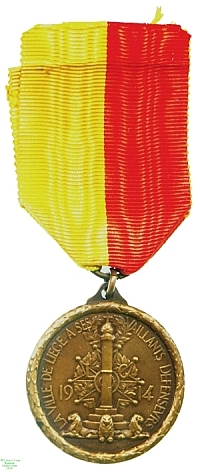
Obverse, soldiers amid shattered defences

Reverse, the Liège Perron (War Memorial) against a star and foliate background

Obverse, soldiers amid shattered defences |

Reverse, the Liège Perron (War Memorial) against a star and foliate background |
German strategy at the outbreak of the Great War relied on a rapid and crushing defeat of French forces to enable a response in force to the slower-moving threat of Russia on the Eastern Front. The extensive preparations of French defences however meant that for surprise and maximum effect such an attack would have to be delivered via neutral Belgium.
Thus when the war began in 1914, one of the first German targets was the defensive complex around the Belgian town of Liège. Initial attacks on 5 August were driven off, despite Zeppelin bombing raids, but on 7 August German forces occupied the town, with infamous savagery. An outer ring of forts remained obdurate, however, for another ten days, being reduced one by one by the heaviest artillery available to the Germans without any hope of relief.
In 1920 this heroic but vain defence was commemorated with the issue of the Médaille de Liège to all survivors from the defending forces by the town's mayor, Gustave Kleyer. This example bears no name, and its recipient is unknown. Lester Watson purchased it from the London dealers Baldwin in 1927.